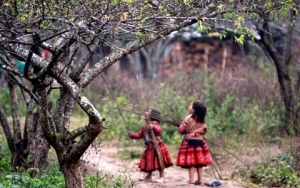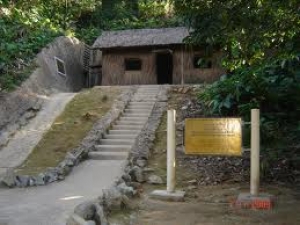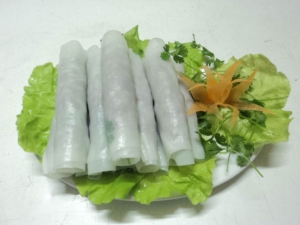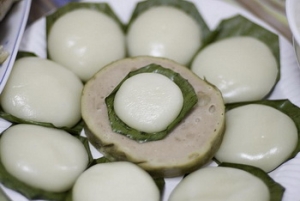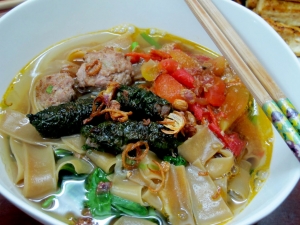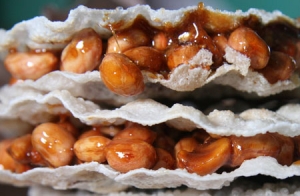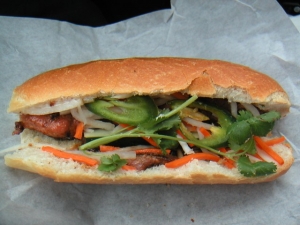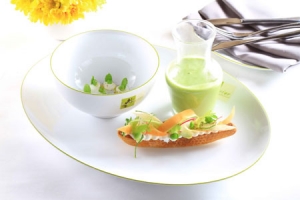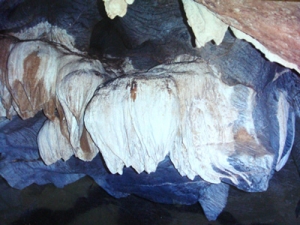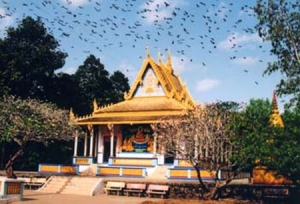
Asia Pacific Travel Team
Moc Chau- A new strange destination to be discovered in Vietnam tourism
Most green tea is grown in the farm town of Moc Chau (Moc Chau old town). This place is regarded as the largest and the most beautiful highland among northern mountainous areas of Vietnam. Why don’t you take time to visit Moc Chau and look at the immense fields of green tea?
It’s surprised that right from the first kilometers to this land, tourists are welcomed and strongly attracted with long straight lines covered by green tea waves.
Most famous green tea plantations in Moc Chau farm town are listed as Tan Lap, Co Do, etc.
Please enjoy some photos of green tea fields in Moc Chau Plateau as followings:
Muong Phang- An ecological and historical tourism attractive destination to tourists in Vietnam travel
Along the road to Muong Phang commune, there are beautiful mountains, forests, and particularly a 60 ha reservoir which provides water to the hydroelectric projects of Thac Bay and Na Loi. The reservoir consits of hundreds of small islands and over 200 ha of forest vegetation cover floristic composition, therefore it’s very potential for eco-tourism development.
Muong Phang commune still keeps the historical relic site of the Dien Bien Phu Campaign Headquarters.
In reality, there is a primeval forest with century old trees which is called with respect by Dien Bien people “Forest of the General Vo Nguyen Giap”, as it is connected closely with General Vo Nguyen Giap who led the Dien Bien Phu Campaign to the world shaking victory. The forest is the place where the General Headquarters of the Dien Bien Phu Campaign was located and now becomes an ideal destination for those who want to come to see the vestiges of the battlefield.
Tourists in Vietnam travel to the relics will have chance to pass through the 69 m long tunnel through the mountain where General Vo Nguyen Giap and Major General Hoang Van Thai and other commanders discussed military affairs.
Tourists to the place can also learn about the hardships of commanders and soldiers that they had to bear during the war time. From the commander tunnel to the mountain is around 6 km.
Moving up to Pu Huot Mount is where General Vo Nguyen Giap placed watch tower. From there, visitors can see the whole Dien Bien Phu town, Muong Thanh valley and entrenched fortifications of French troops such as Him Lam Hill, Doc Lap Hill, D1 Hill, Muong Thanh bridge, etc.
Nowadays, together with the natural landscapes, the whole relic site of Dien Bien Phu Campaign Headquarters has been well-preserved and restored to attract both local and international tourists and also war veterans come to see the vestiges of the former battlefield.
Coming to Muong Phang, visitors joining tours in Vietnam not only have opportunities to enjoy the imposing natural landscapes of the region but also understand more about Vietnam’s history.
Pho cuon: A favourite dish for hot summer in Hanoi
Many people believe that such dishes, by inducing sweat, really help lower ones body temperature and help fight the heat. Not everyone feels that way. One cool and refreshing alternative is Pho Cuon, a food similars to fresh spring rolls, but basically different in a number of ways.
The most famous places to find the dish are located on Truc Bach lake,opposite West Lake, Hanoi's largest lake. There are lots of places that offer Pho Cuon around the lake, but the easiest way to find are on Trúc Bạch road, on the north end of the lake, or Tran Vu on the south end.
Pho Cuon consists of a slightly cooked rice paper shell the same thickness as a Pho noodle. Inside this soft shell is a selection of herbs and greens - mainly cilantro, lettuce and mustard leaf - and thinly sliced beef that has been cooked with garlic and generous amounts of pepper. It is served cold with a bowl of fish sauce, boiled water, garlic, carrots, raddish, vinegar, chilli and some sugar for dipping.
Once dipped in the sauce the taste of Pho Cuon contains many of the fundamental elements of Vietnamese cuisine: slightly sweet and spicy but light and fresh. The dish is served cold and has the effect of a hearty salad on one's appetite leaving plenty of room for a few cheeky beers or to try some other delights that many of these restaurants offer like Pho Chien.
Pho Chien is similarily light summer fair; it uses the same rice noodle paper as Pho Cuon but is sliced into squares, stacked, and deep fried. It is topped with the same garlicky beef as well as field cabbage and recommended that one dip it in the Phở Cuốn sauce.
Hours can easily slip by sitting cross legged on bamboo mats as one enjoys the cool breeze of the lake and a few plates of Pho Cuon with friends. Tourists with Vietnam travel guide see a different, more relaxed side of Hanoi, as old men fish and young couples paddle along leisurely in swan boats. It is the ideal place to wile away one's time under the shade of a tree and await the cooling relief of evening.
The Pho Cuon restaurants on Truc Bach are open from morning till about nine or ten at night. The cost for a plate of about ten Phở Cuốn, a plate of Pho Chien, and four beers is just around VND200,000 (US$10). For the relief it offers from the heat, it's a steal.
Top breakfast foods in Vietnam
Breakfast is something we often ignore when talking about cuisine. Want to find out what Vietnamese people eat for breakfast? Let's have a taste of Vietnamese breakfasts follow you feel they are really delicious foods when coming to Vietnam.
1. Pho
Pho is soup with rice or wheat based noodles that's flavored with a meat such as beef, chicken, or pork . Fresh ingredients are added to the soup or act as a topping for the soup. These ingredients may include : chopped chilies, roasted peanuts, shallots, basil, lime, bean sprouts, cilantro. Vietnamese parsley and garlic. A fish or chile sauce is almost always served with the soup. Best variety of Pho are Pho Bo Tai (rare fillet) and Pho Ga (boneless white chicken meat), Pho Bo Gau, Pho Bo Tai Nam and Pho Sot Vang. Lemon and chilly are indispensible for the best taste of Pho.
2. Bun (Rice Vermicelli)
Bun is made of rice flour but instead of flat triangle shape like Pho, Bun has small and circular shape. Recipes to make Bun’s broth are even more diverse than Pho, which result in different vermicelli dishes, most varity of Bun are Bun Cha (vermicelli and grilled chopped meat), Bun Rieu (vermicelli and crab meat soup), Bun Ca (vermicelli with fried fish), Bun Thang (varied vermicelli) and Bun Oc (vermicelli and snail), of which Bun Bo (vermicelli with beef) is specialty of Hue. Specific trait of Bun is an adequate sour taste the main ingredients of their soup are tomato, garcinia cowa and lemon lime. If you walk along some streets and stop at one rice vermicelli vendor in Hanoi or Sai Gon, you will have many chances for tasting various dishes of rice vermicelli with unforgettable flavor.
3. Mien (Cellophane Noodles/ Glass noodles)
Mien has a similar shape to Bun; however, this Chinese originated noodle is not made of rice flour; seaweed and cassava flour are used instead. That is the reason why Mien is a less-calorie food as well as a vegetarian favorable by on-diet people. Basically, main components of Mien’s broth is the same with Pho, but its spices are sourer and maybe more fishy because Mien usually eaten with sea-foods. Mien Luon (Mien with eal) is the most popular type of Mien in Vietnam, especially in Hanoi. Other variables of Mien are Mien Cua (Mien with crab meat) or Mien Ga (Mien withj chicken), Mien Ngan (Mien with goose meat).
4. Xoi (Sticky Rice)
Pho and Xoi are popular for breakfast in Vietnam. Even in the smallest lanes in Vietnam ones can find a street-stall selling Xoi in the morning or recognize one or two people carrying a basket of Xoi, covered by banana leaves. This sticky rice varies from simple low-price, some of them are Xoi Do Xanh (Xoi with green beans), Xoi Gac (Xoi colored with Gac’s oil), Xoi Ngo (Xoi wih corns), Xoi Com, Xoi Lac (Xoi with peanuts) or for commoners to higher ranks like Xoi Trung (Xoi with egg), Xoi Cha (Xoi with meat rolls) or Xoi Pate (Xoi with past ).
5. Cháo (Congee/Porridge)
Congee or rice porridge is one of the most common meals in Vietnam for breakfast, lunch or dinner. Cháo is very to cook since almost every electronic rice-cooker has porridge cooking function. Although it is considered as the poor’s food, but Cháo could be much fancier when cooked with a variety of meats. There are some kind of Chaos are Chao Ga (chao boiled with a whole chicken with bones to get the tastiest broth), Cháo Vịt (porridge with duck); Cháo Lươn (porridge with eel) and Cháo Cá (porridge with fish).
6. Trứng Vịt Lộn (Balut)
Trứng Vịt Lộn is actually duck’s embryo still laying in its shell going through fertilization process and then boiled in steamy heat. Because of this characteristic and its appearance, this dish is listed among the most terrific food for Western visitors. Nevertheless, if ones can manage your fear to taste it one time, you may find it thousand times more delicious than normal chicken egg as well as a huge amount of protein good for your heart. In Vietnam. It is favored by most people and appears in every breakfast stalls.
7. Banh Mi (Vietnamese Bread)
The sandwiches made from bánh mì include meat and soy fillings such as steamed, pan-roasted or oven-roasted seasoned pork belly, Vietnamese sausage, grilled pork, spreadable pork liver pâté, pork floss, grilled chicken, chicken floss, canned sardines in tomato sauce, soft pork meatballs in tomato sauce, head cheese and fried eggs. Accompanying vegetables such as fresh cucumber slices, cilantro (leaves of the coriander plant) and pickled carrots and daikon in shredded form. Spicy chili sauce is normally found in bánh mì sold by vendors in Vietnam.
8. Banh Cuon (Rice Flour Steamed Rolls)
Rice seems to be the mother of many Vietnamese delicious foods, yet, another specialty made of rice flour: Banh Cuon. It is covered by a thin, wide sheet of steamed rice flour and its core filled with seasoned ground pork, and minced wood ear mushroom. Banh cuon is usually served with Cha Que and special dipping sauce named “nước chấm” made only for Banh Cuon.
10.Banh Bao
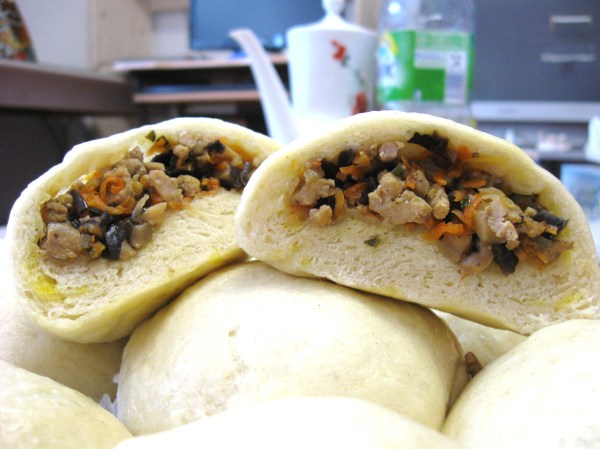
Banh bao is a simple but delicious food; it’s basically a large, round dumpling filled with various ingredients include pork, onion and sausage mushrooms. The most popular version in Saigon is a mixture of ground pork, hard-boiled quail egg and Chinese sausage. The ground pork is formed into a meatball and then the eggs and chunks of sausage are added.
The mixture is then wrapped in a slightly sweetened flour dumpling and steamed to perfection. On the street, banh bao is served directly out of the steamer so you’ll want to give it some time to cool before you dig in, or you may burn your mouth.
10. Vietnamese's 'banh'
In this section we won’t discuss about an individual type of food but dozens of them. Because it is Vietnam food offers too many breakfast cakes and each of them is as popular and tasty as one another. Some most common cakes can be named as Bánh Chưng Rán, Bánh Nếp, Bánh Tẻ, Bánh Giò, Bánh Khúc, Bánh Rán, Bánh Tôm, Bánh Đúc, or Bánh Dày. There are still many more Vietnamese traditional cakes can be used for breakfast which may cost a whole essay to list out not to mention trying all of them. These are often savoury and easy to pack (like mochi in Japan) and often stuffed with mung beans. Tourists can find them in many street food stalls and from the ladies wandering the streets with a pile of Banh on their shoulder.
(Collected)
"Banh Da Cua" speciality of Hai Phong in Hanoi
This dish is primarily a breakfast dish found in the early mornings of Hai Phong when the shops are opening around 7am. If you wait too long or don’t get up in time, these places can be closed by around 11am however it is possible to find a few places around that do sell it at night along the streets as well. If you leave Hai Phong, it may be found some places to sell " Banh Da cua" in Hanoi.
A bowl of delicious and attractive noodles musts enough to converge in five colors: pink brown of crab, brown noodles, green color of vegetable, green onion, lemon; fresh red colour of chili and yellow colour of dry onion. The very eye-catching colors combined with greasy tasty has been attracted even once enjoyed. When given the opportunity to Hanoi, you should try a bow of " Banh da cua" has to be able to share "emotional honesty" of this unique cuisine.

For this, at first, the noodle has to be carefully picked and processed. The noodle makers in Hải Phòng specialize in rice selection, grinding, powdering and cooking. Rice to make noodle must be high-quality and put in water one hour (in summer) and ten hours (in winter).After cooking,brown noodles are soft and tough and the broth must be clear in harmony with colours of ingredients. Floating above the broth is the red-brown crab ,pieces of lốt leaves is very green, the slightest yellow dried onion, the tiny vegetables.
Kẹo Cu-đơ, a speciality of Ha Tinh Province
Kẹo Cu-đơ is made from natural ingredients such as: peanut, cane molasses, malt powder, sesame, and ginger. Candied peanut is itself delicious. Kẹo Cu-đơ (peanut rice-paper candy) is a famous food of the central province of Ha Tinh.
In Vietnamese kẹo means candy, and Cu-đơ is the nickname locals gave the man who changed the traditional form of making candy. People snicker while eating it because Cu-đơ is a play on “stiff penis.”
In the past it used to be called just kẹo lạc (peanut candy).
Cu-đơ was a seller of peanut candy and green tea who had the novel idea of putting rice paper under the peanut candy instead of wax paper that was used traditionally to prevent the candy from sticking.
This clever idea meant the crispy rice cracker made the candy even tastier.
Kẹo Cu-đơ is made from natural ingredients like peanut, cane molasses, malt powder, sesame, and ginger.
The process may seem simple but it is not really so, and one has to strictly follow it to achieve the right taste.
For delicious kẹo Cu-đơ, one needs pure cane molasses. If the molasses is not pure and is mixed with sugar, the peanut will not taste as good, spoil easily, and it will melt in hot weather.
Put cane molasses in a pot on the stove. Cook until it melts and starts bubbling. Add ginger, sesame, and malt powder to soften the molasses.
Stir the mixture constantly. When it is bubbling, add the peanut to the pot. If the peanut is added at the right time, it will be crispy and fragrant and melt in the mouth.
Stir it one direction, otherwise the skin will peel off or the nuts will sink to the bottom and burn, making the kẹo Cu-đơ bitter.
When the mixture is done, pour it between two grilled rice papers.
The candy must be not too thin or thick.
Five or ten of them are put together in an airtight nylon bag to keep them fresh and crispy.
Kẹo Cu-đơ is perfect when it has the sweet taste of cane molasses,crispiness of the rice paper, and greasy, the pungency and slight spiciness of ginger, buttery taste of peanut. It is a popular dish when served with hot green tea.
Source: Thanh Nien New
Banh mi- in the list of world top street foods
When you cruise the elegant French colonial vestiges of Ho Chi Minh City (Saigon), stop off at a streetside stall for the Vietnamese take on its former colonisers’ simple salad sandwich – banh mi is a piece of history wrapped in a baguette.
“Tender chunks of grilled pork swaddled inside fluffy French bread combine with Vietnamese mayonnaise, coarsely chopped pickled daikon radish and carrot, together with a touch of eye-watering chili sauce, to create the best East-meets-West moment you’ll ever taste. Close your eyes, take a bite and be transported back to the grand imperial days of old Saigon,” it continues.
Other dishes to make the cut were chouriços from India, kushari from Egypt, dosas from America, and arepas from Colombia.
At Vietnamese bakeries in the US, Canada, Australia, and France, the term banh mi refers to a type of meat-filled sandwich. In Vietnam, it is used for all kinds of bread. People often add words to describe the fillings, such as banh mi ga (bread filled with chicken) or banh mi pâté thit (a sandwich with pâté and pork).
Authentic French cuisine in Saigon
French cuisine seems very popular in Ho Chi Minh City judging from the many restaurants that are constantly springing up.
But to enjoy authentic French food in a luxurious setting, gourmets should look no further than L'Olivier Restaurant at the Sofitel Plaza Saigon Hotel, District 1, which deservedly enjoys the reputation of being among the best in town.
L'Olivier has rustic limestone walls, a modern lighting system, and, redolent of southern France and the Mediterranean many trees, some as tall as three meters.
The restaurant is divided into four parts: the main dining area, a terrace for those who enjoy eating outdoors, a spacious and well-lit garden, and two private dining areas for business meetings and family get-togethers.
À la carte menu at L’Olivier
The restaurant has brought together many outstanding chefs from Europe, especially France, including executive chef Tjaco van Eijken, who has been working in the food industry for more than 18 years.
He began as a junior sous chef at the 2-Michelin-star “La Rive” Restaurant in the Netherlands. Then, he joined Sofitel Demeure Hotel Castille in Paris where he became chef de cuisine at its Michelin-star fine dining restaurant Il Cortile.
L’OLIVIER RESTAURANT
2nd floor, Sofitel Saigon Plaza Hotel
17 Le Duan Street, District 1, HCMC
Tel: (08) 3 824 1555
Email:
This email address is being protected from spambots. You need JavaScript enabled to view it.
After that he was executive chef for the Hotel InterContinental in Hongkong and the Sofitel Brussels Le Louise. After discovering an interest in Asian cuisine, he found Vietnam to be the place to undertake his new culinary adventure.
At L'Olivier he has designed a new à la carte menu with a Mediterranean touch featuring a selection of dishes to accommodate both the fast-paced business crowd and relaxed leisure guests.
The menu consists of authentic Mediterranean cuisines such as French, Italian, Spanish, and Moroccan.
It features starters like ravioli of crab and arugula, crispy vegetables, mixed herbs; custard of Parisian mushrooms served with watercress jus; and fried frog legs with snail butter. Then there is the irresistible roasted green asparagus with aged Parmesan cheese and balsamic reduction, supposed to be a delicacy in the new menu.
For the main course, the chef offers many different dishes to please all palates - such as tajine of poultry, green olives and lemon confit with couscous garnish from Morocco and roasted fillet of veal with creamy bacon, porcini, and potato gnocchi from Italy. The slow-cooked beef cheek, Provencal jus, and waffle potatoes comes highly recommended.
Last but not least is the array of mouth-watering desserts like cheeses, fruits, and chocolates. Customers are recommended to try some signature dishes such as exotic fruit with shiso jelly, yoghurt waffle potatoes sorbet, and crispy mango; and caramelized raspberries and strawberries, white chocolate dome, and orange sorbet.
L’Olivier serves the à la carte menu for business set lunch and dinner daily. Lunch is between 11:30 a.m. and 2 p.m. and dinner is from 6 p.m. to 11 p.m.
It has had more than 12 Michelin Star chefs so far, including Jean-Baptiste Natali from Hostellerie de la Montagne Restaurant in Colombey les deux Eglises (Champagne), Ulrich Heimann from Le Ciel in Berchtesgaden (Germany), and, most recently, Gilles Reinhardt from Maison Paul Bocuse in Collonges (Lyon).
The Charming Beauty of Coc Ly Fairy Cave
Although Coc Ly fairy cave was discovered by the local residents very soon, its beauty and poetic started being known widely few years ago after the development of the local tourism, especially when Bao Nhai-Coc Ly market travel tour was established.
People call Coc Ly a fairy cave because of its association with the legend of three fairies. The three fairies , allowed to visit the human world by Ngoc Hoang, were fascinated by the charming beauty of Coc Ly cave and they didn’t want to go back to the sky. This made Ngoc Hoang angry so he let Thien Loi down to pusnish the fairies. Finally, the three fairies jumped to the water to commit suicide and their dead bodies were found by the local people at the downstream (centre of Bao Nhai, Bac Ha district nowaday). A temple named Ba Co which was built for the cult of three fairies is said to be very sacred.
Coc Ly fairy cave is a special destination included in the Chay river travel tour. There are populations of three caves which have different beauties. Visiting Coc Ly cave, visitors will be fascinated by a world of stalactites which are in various shapes and covered by the vine curtain at the entrance.
The cave looks like a majestic maze, its stalactites form the shapes of flowers, big lotus and the inside space is so magical because of the rare light radiating from outside. The bats also choose the cave to be their residential place.
Doi Pagoda – One of the best tourist attractions in Soc Trang
Located on Le Hong Phong St., 2km from Soc Trang downtown, Doi (Bat) pagoda is the most famous pagoda in Soc Trang province. It was built in the 16th century and is one of the oldest pagodas in the province. The pagoda is famous for its beautiful architecture, especially its very large roof that houses tens of thousands of bats. It presents an opportunity to contemplate Khmer arts, with skilful, symbolic decorations on its pillars and roof and splendid relieves and statues.
Apart from its beautiful architecture, the pagoda is also remarkable for the large number of bats roosting in the trees behind the pagoda. Watching the bats take to the skies, it will occur to you that the pagoda is a unique natural reserve. Visitors in Vietnam travel can see thousands of bats swinging in immeasurably-high branches, as if performing in a circus.
Now, Doi Pagoda is preserving a stone Buddha statue which is 1.5m high, as well as many bibles written on sugar palm leaves, known as “leaf-books”.
With a large space for trees, Doi Pagoda is a tranquil place to sit and becomes one of the best tourist attractions in Soc Trang province.


